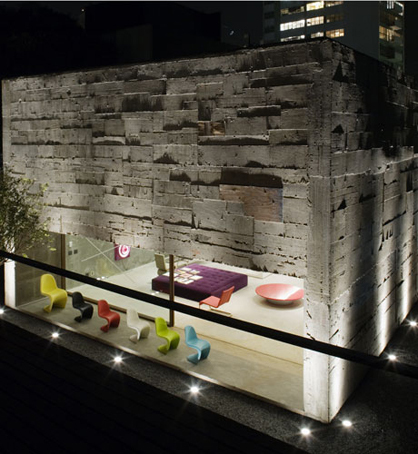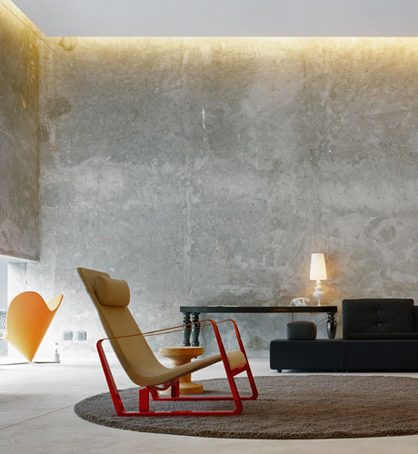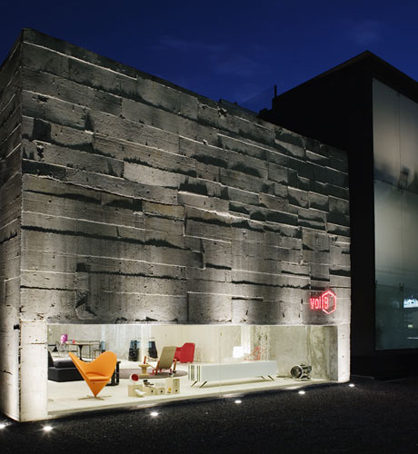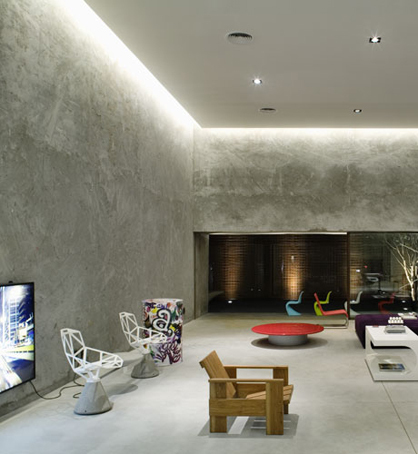Vitra in Brazil
Text von Architonic
Schweiz
21.07.08
Written by Maya Jordan, Photos by Nelson Kon and Fran Parente
This Store Micasa Volume B is an annex, of a previously existing store. A small tunnel connects the entrance with the showroom of the initial store, and is installed perpendicularly in relation to the new space. A patio located at the end of the lot gives access to the store and the design studio. The annex interior ground plan is a large span, conceived to configure an ample and dynamic area to house the VITRA showroom, which Micasa sells. The front facade is a broad showcase of instigating proportion, low and long, which every now and then displays the owner’s antique car collection. The project author is Marcio Kogan.
Popular urban Brazilian civil construction, with the consolidation of previously-precarious neighborhoods, executed with disposable material, has specialized in the building of that which was called “puxadinhos” (annexes), small enlargements, be they vertical or horizontal, taking over all the small lots. The formal city has incorporated this culture and has suggested, in the ever-new Latin-American cities, always fresh, always renovated, a program for architecture: building on the already-built. The store was built using rustic material and rustic executions.
Rustic and modern, Micasa Volume B recalls the artisan processes of popular civil construction, and, above all, the modern Brazilian buildings, brutalist projects in a brutalism reinvented south of the equator, attentive to the local knowledge. The facades of the store were made in a not-very-common manner using exposed reinforced concrete: the outward appearance of the material, generally done very precisely with new lumber, is used here randomly, chaotically, and some wood was not even removed after curing. The brises-soleil in the offices is made of a net of reinforcing bars used for the concrete.This delicate steel lace placed vertically, function as light filters in the large windows.
The external pebbles are made from the crushed rock used to produce concrete. The building itself was fundamental to the project; actually, the project was complemented and recreated in the building itself. Some of the solutions used, such as the reinforced concrete and the metallic lace, were decided at the work site and part of the creative process was transferred to the builders. The memory of the construction remained, in an exposed archeology of the building: the “x’s” of the tape on the new windows and, on the inner walls, the workers’ notes on the project.These walls have no revetment, no paint: a raw texture of the material provides the finishing.The finalized building, beginning with the use of these materials, delicately displays the constructive phases; they are x-rays of the entire project and the work site, marks of the building’s recent history that, with the passing of time, have been added on to the always-new cities of the southern hemisphere.
project: volume B
location: Sao Paulo SP
project: November 2006
construction: May 2007
site plan area: 504 sq m
builted area: 250 sq m
author: Marcio Kogan
co-author: Bruno Gomes, Bruno Guedes
project architects: Diana Radomysler, Oswaldo Pessano, Renata Furlanetto, Samanta Cafardo, Suzana Glogowski, Lair Reis, Carolina Castroviejo, Eduardo Glycerio, Maria Cristina Motta, Gabriel Kogan, Mariana Simas
adresss: Al. Tiete, 505 – Sao Paulo Sp, Cep 01417-020, Brazil







